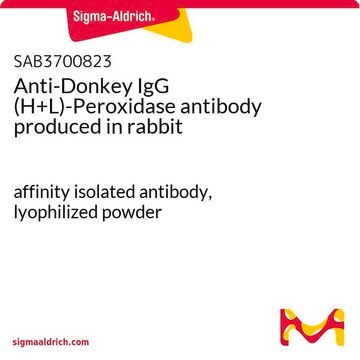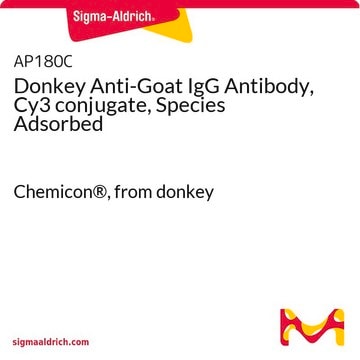AP192C
Donkey Anti-Mouse IgG Antibody, Cy3 conjugate, Species Adsorbed
Chemicon®, from donkey
Sign Into View Organizational & Contract Pricing
All Photos(1)
About This Item
UNSPSC Code:
12352203
eCl@ss:
32160702
NACRES:
NA.46
Recommended Products
biological source
donkey
Quality Level
conjugate
CY3 conjugate
antibody form
affinity purified immunoglobulin
antibody product type
secondary antibodies
clone
polyclonal
species reactivity
mouse
manufacturer/tradename
Chemicon®
technique(s)
immunofluorescence: suitable
shipped in
wet ice
target post-translational modification
unmodified
Related Categories
General description
Immunoglobulin G (IgG), is one of the most abundant proteins in human serum with normal levels between 8-17 mg/mL in adult blood. IgG is important for our defence against microorganisms and the molecules are produced by B lymphocytes as a part of our adaptive immune response. The IgG molecule has two separate functions; to bind to the pathogen that elicited the response and to recruit other cells and molecules to destroy the antigen. The variability of the IgG pool is generated by somatic recombination and the number of specificities in an individual at a given time point is estimated to be 1011 variants.
Specificity
Specific for mouse IgG, heavy and light chain.
Application
Research Category
Secondary & Control Antibodies
Secondary & Control Antibodies
Research Sub Category
Secondary Antibodies Adsorbed for Dual Labeling
Secondary Antibodies Adsorbed for Dual Labeling
This Donkey anti-Mouse IgG Antibody, Cy3 conjugate, Species Adsorbed is validated for use in IF for the detection of Donkey Mouse IgG.
Physical form
ImmunoAffinity Purified
Lyophilized. Buffer = 0.01M Sodium Phosphate, 0.25M NaCl, pH 7.6 with 15 mg/mL BSA, and 0.05% sodium azide.
Storage and Stability
Store lyophilized material at 2–8°C for up to 1 year from date of shipment. After reconstitution this product is stable for several weeks at 2–8°C as an undiluted liquid. DO NOT FREEZE. Store away from light. For extended storage after reconstitution, add an equal volume of glycerol (ACS grade or better) to make a final concentration of 50% glycerol and store at 2–8°C for up to 6 months. Avoid repeated warming/cooling cycles. Please note that the concentration of protein and buffer salts will decrease to one-half of the original after adding glycerol.
Other Notes
Concentration: variable
Legal Information
CHEMICON is a registered trademark of Merck KGaA, Darmstadt, Germany
Disclaimer
Unless otherwise stated in our catalog or other company documentation accompanying the product(s), our products are intended for research use only and are not to be used for any other purpose, which includes but is not limited to, unauthorized commercial uses, in vitro diagnostic uses, ex vivo or in vivo therapeutic uses or any type of consumption or application to humans or animals.
Not finding the right product?
Try our Product Selector Tool.
hcodes
pcodes
Hazard Classifications
Aquatic Chronic 3
Storage Class
11 - Combustible Solids
wgk_germany
WGK 3
Certificates of Analysis (COA)
Search for Certificates of Analysis (COA) by entering the products Lot/Batch Number. Lot and Batch Numbers can be found on a product’s label following the words ‘Lot’ or ‘Batch’.
Already Own This Product?
Find documentation for the products that you have recently purchased in the Document Library.
M T Klein et al.
British journal of pharmacology, 166(4), 1290-1302 (2012-01-21)
The 5-ht(1E) receptor is highly expressed in the human brain and its structure is conserved in humans, suggesting an important physiological role for 5-ht(1E) receptors. However, neither the function nor the distribution of this receptor has been characterized in the
Neuroprotective effect of the endogenous neural peptide apelin in cultured mouse cortical neurons.
Zeng, XJ; Yu, SP; Zhang, L; Wei, L
Experimental Cell Research null
Low Mr phosphotyrosine protein phosphatase associates and dephosphorylates p125 focal adhesion kinase, interfering with cell motility and spreading.
Rigacci, S; Rovida, E; Dello Sbarba, P; Berti, A
The Journal of Biological Chemistry null
Liang-Qin Hou et al.
Development, growth & differentiation, 50(7), 531-541 (2008-05-29)
To define a genetic network that regulates development of the pancreas, we used high-density microarray (Affymetrix) to generate transcriptional profiles of rat pancreas from five biologically significant stages of development: embryonic day 12.5 (E12.5), E15.5, E18.5, postnatal day 0 (P0)
Xiao-Yan Liu et al.
World journal of gastroenterology, 15(14), 1738-1743 (2009-04-11)
To investigate the expression of alpha-fetoprotein (AFP), a cancer-associated fetal glycoprotein, and its involvement during rat colon development. Colons from Sprague-Dawley rat fetuses, young and adult (8 wk old) animals were used in this study. Expression levels of AFP in
Our team of scientists has experience in all areas of research including Life Science, Material Science, Chemical Synthesis, Chromatography, Analytical and many others.
Contact Technical Service








